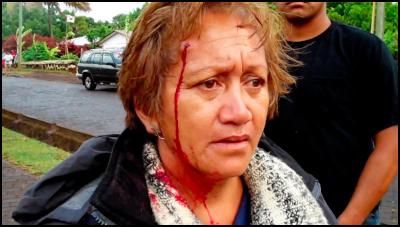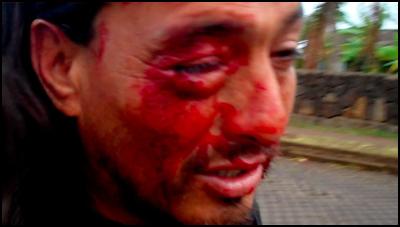Chilean troops open fire in Easter Island - Warning Graphic
Chilean troops open fire in Easter Island
WARNING GRAPHIC CONTENT!
The Pacific Conference of Churches is concerned about the escalating violence on Easter Island and pleads with the authorities to restrain from using force and arms and urges all parties to seek a peaceful outcome.
This after armed Chilean soldiers opened fire early Friday morning (3 December 2010) on unarmed Rapa Nui civilians using automatic rifles, tear gas and shotguns as the Chilean government moves in to remove the indigenous owners off their land. Among the casualties is the president of the Rapa Nui Parliament, Leviante Araki, who was shot twice and has been airlifted to Santiago, the Chilean capital for medical treatment.
Tension had been escalating for months after the Chilean government refused to hold meaningful discussions on the peaceful reoccupation of land by the Rapa Nui people. Rapa Nui is the Spanish name for Easter Island, a Polynesian island in the southeastern Pacific Ocean.
The island was taken over by Chile in 1888. Under current Chilean law, land could be given back to the indigenous owners through the issuance of titles. The attack began at around 5:45am when Chilean troops began rounding up and beating unarmed civilians.
The civilians defended themselves by throwing rocks back to the soldiers who then opened fire using automatic rifles, shotguns and tear gas. Other injuries reported include Richard Tepano, a young man shot at close range in his right eye; Maori Pakarati, shot above his right eye and arm; Zita Atan who was shot in the head; Pia Vargas shot in her right leg; Honu Tepano shot in the shoulder; Claudio Tuki shot in the forehead; Enrique Tepano shot in the face; Santi Hitorangi shot in his right leg from behind and twice in the back.
On Thursday, the Governor had asked the Rapa Nui people to evacuate their premises, who refused to move. The judge who authorized the order for the soldiers to move in has reportedly disappeared. The Chilean government wants ownership of Easter Island because of the economic gains it would receive from the archaeological treasures on the island.
Easter Island is widely famous for its 887 extant monumental statues, called the Moai, created by the early Rapa Nui people. The statues are a World Heritage Site. The Rapa Nui people comprise 60 percent of a population of around five thousand.
Attached are some pictures of the casualties.



ENDS


 UNODC: Cyberfraud in the Mekong reaches inflection point
UNODC: Cyberfraud in the Mekong reaches inflection point Gary M. Feinman, IMI: Archaeology Can Now Tell Us How People Have Muffled And Challenged Economic Inequality Across History
Gary M. Feinman, IMI: Archaeology Can Now Tell Us How People Have Muffled And Challenged Economic Inequality Across History CNS: Will All Children Be Born Free Of HIV, Syphilis And Hepatitis-B By 2030?
CNS: Will All Children Be Born Free Of HIV, Syphilis And Hepatitis-B By 2030? Save The Children: Sudan - One Child Every 10 Seconds Forced To Flee Their Home Since Conflict Began Two Years Ago
Save The Children: Sudan - One Child Every 10 Seconds Forced To Flee Their Home Since Conflict Began Two Years Ago People with Disability Australia - PWDA: People With Disability Invisible In Election Debates And Housing Promises
People with Disability Australia - PWDA: People With Disability Invisible In Election Debates And Housing Promises East West Center: NZ Deputy Prime Minister Recounts Longstanding US-NZ Relationship In The Pacific
East West Center: NZ Deputy Prime Minister Recounts Longstanding US-NZ Relationship In The Pacific